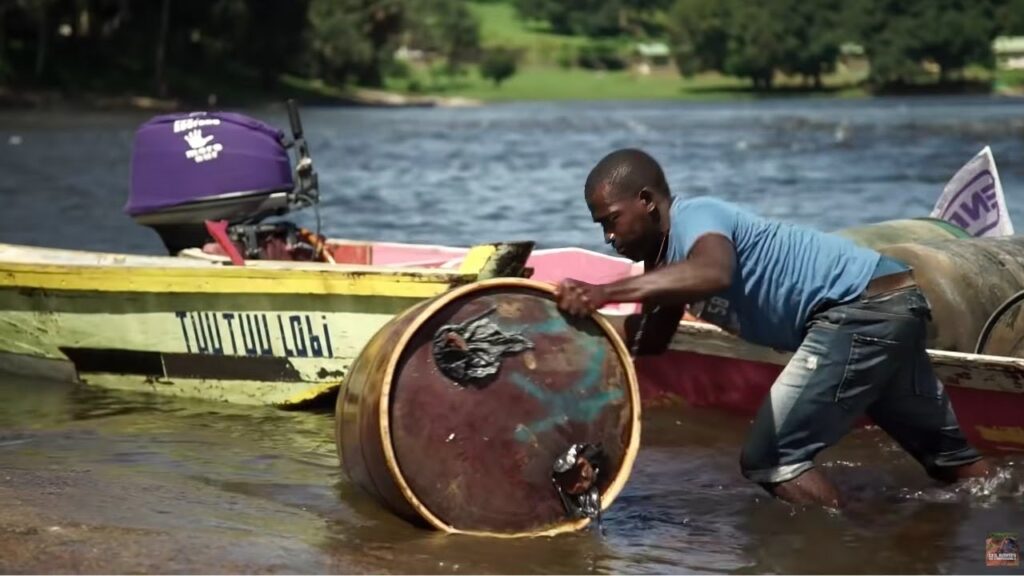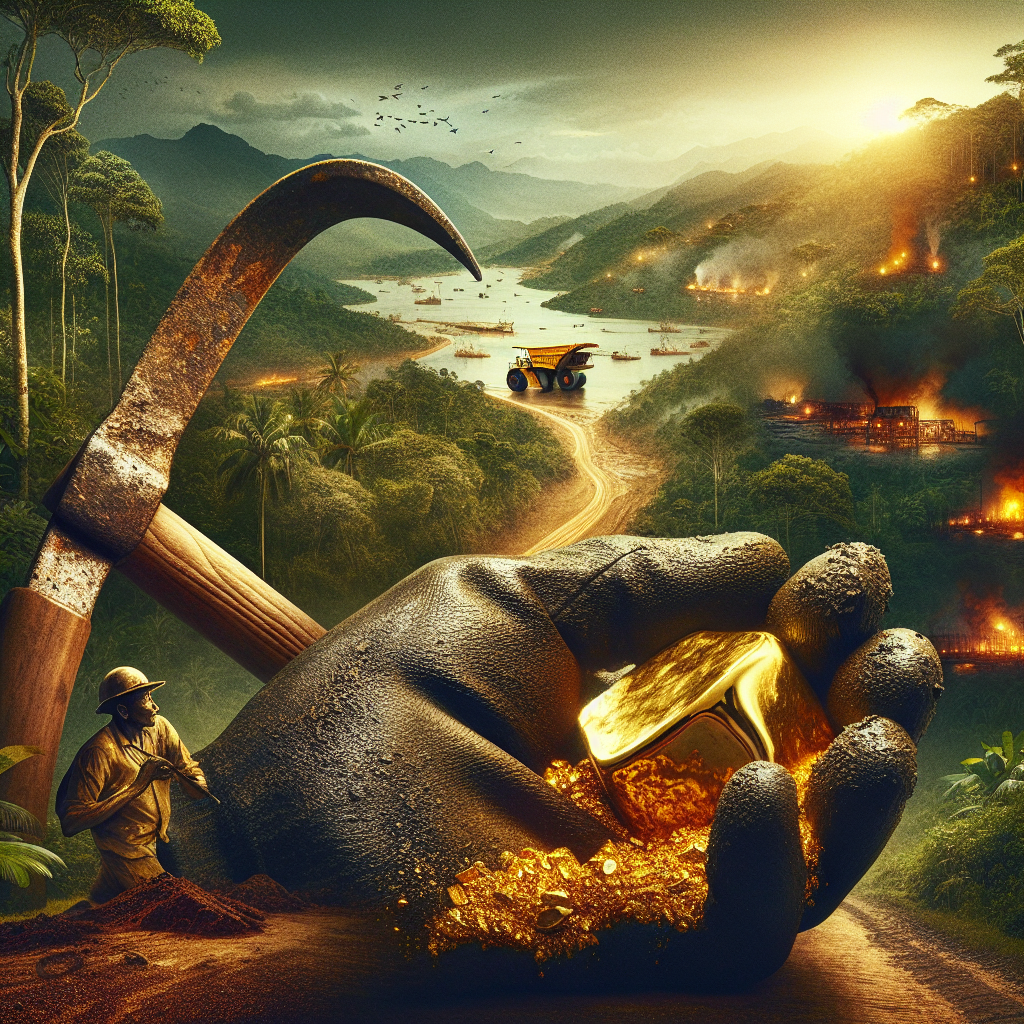Suriname: Pour une poignée d’or – Les routes de l’impossible is a captivating video that takes you on a journey through Suriname, a jungle country located in the heart of the Amazon. The video explores various locations such as the Maroni River, the village of Mongotapoe, the multiethnic city of New Nickerie, and the stunning Asinodopo and Bhongo waterfalls. It follows the struggles of Pedro and Francisca, gold diggers who rely on their boat to travel through the treacherous jungle and make a living. The video, directed by Paul Comiti and David Geoffrion, offers a unique perspective into the challenges faced by those living in this remote and adventurous land.
In Suriname, a country covered with virgin forests spanning 163,000 square km, roads are scarce. The primary mode of transportation is through the vast network of rivers. With a population of barely half a million, most residents live in the capital city of Paramaribo. The video showcases the adventure and determination of Pedro and Francisca, as they navigate their boat through dangerous waters in search of gold, all in the hopes of securing a better future for their family. This journey through Suriname is not for the faint of heart, but for those who have a goal worth fighting for, the impossible becomes possible in this mesmerizing land of the Amazon.
Introduction
Suriname is a jungle country located at the heart of the Amazon. Despite being difficult to locate on a map, Suriname covers an area of 163,000 square km, which is equivalent to the sixth of France and is covered with virgin forests.
In this article, we will explore the unique features of Suriname, including the Maroni River, the village of Mongotapoe, and the multiethnic city of New Nickerie. We will also delve into the challenges of traveling in Suriname, particularly the difficult terrain and low population density, as well as the importance of rivers for transportation. Additionally, we will learn about the gold mining industry in Suriname and the perils faced by gold diggers like Pedro and Francisca.
We will also discover the journey to Mongotapoe, the challenges faced in surviving the jungle, and the breathtaking waterfalls, Asinodopo and Bhongo. Furthermore, we will explore the struggle for resources, including the donation of gasoline by the state, and the search for a new engine. Lastly, we will navigate the treacherous Maroni River and explore the multiethnic city of New Nickerie.
Suriname: A Jungle Country

Best Deals to Surinam by BOOKING.COM
Location and Size
Suriname is a jungle country located in the heart of the Amazon. It covers an area of 163,000 square km, making it approximately the size of the sixth of France. Suriname is known for its vast virgin forests, which contribute to its unique ecosystem and biodiversity.
The Maroni River
One of the prominent features of Suriname is the Maroni River. Stretching across the country, the Maroni River is an essential lifeline for local communities. It serves as a means of transportation, a source of water, and a vital resource for fishing. The Maroni River is also significant in shaping the landscape of Suriname, carving through the dense jungles and providing access to remote areas.
Mongotapoe: A Village in the Jungle
Mongotapoe is a village situated in the middle of the jungle in Suriname. With its location on the banks of the Maroni River, Mongotapoe relies heavily on river transportation for goods and supplies. The village is home to a diverse community that has adapted to the challenges of living in the jungle, including limited access to amenities and the reliance on natural resources for sustenance.
FIND YOUR BEST HOTEL IN SURINAM WITH BOOKING.COM
New Nickerie: A Multiethnic City
New Nickerie is a multiethnic city in Suriname, situated on the banks of the Corantijn River. It is known for its cultural diversity, with the Afro-Surinamese, Javanese Muslims, Indians, Chinese, and Indigenous communities living in harmony. The city serves as a hub for trade and commerce, and its markets offer a wide variety of goods from various cultures and traditions.
The Challenges of Traveling in Suriname
The Difficult Terrain
Suriname’s dense jungle and difficult terrain pose significant challenges for travelers. With few paved roads, most transportation involves navigating through rugged paths and muddy tracks. Travelers must be prepared for the arduous journey and the unpredictable conditions they may face along the way.
The Low Population Density
Suriname has one of the lowest population densities in the Americas, with barely half a million inhabitants. The majority of the population resides in Paramaribo, the capital city. The sparse population density and remote locations make traveling in Suriname more challenging, as there are limited infrastructure and services available in many areas.

The Importance of Rivers for Transportation
Due to the lack of extensive road networks, rivers play a crucial role in transportation in Suriname. Boats and canoes serve as the primary means of travel, carrying people and goods through the intricate waterways. The rivers act as natural highways, facilitating movement between villages and remote areas.
The Gold Diggers of Garimperos
The Gold Mining Industry
Suriname is known for its booming gold mining industry, attracting thousands of garimperos (gold diggers) each year. Mostly consisting of Brazilians, these garimperos travel to the remote jungles of Suriname in search of gold deposits. However, this industry comes with its own set of challenges and perils.
The Story of Pedro and Francisca
Pedro and Francisca are two gold diggers who embark on a perilous journey each year to work in the gold mines of Suriname’s rainforest. They leave their family behind, facing the dangers of the jungle and the uncertainties of finding gold. Their story highlights the sacrifices made by the garimperos in pursuit of a better life.

The Perils of the Journey
The journey to the gold mining areas is fraught with dangers, including treacherous terrain, harsh weather conditions, and the threat of wild animals. Garimperos like Pedro and Francisca face the risk of illnesses, accidents, and even confrontations with illegal armed groups. Surviving this journey requires strength, resilience, and a deep determination to find gold.
Surviving the Jungle
The Journey to Mongotapoe
Traveling to Mongotapoe involves navigating through dense jungles, crossing rivers, and enduring treacherous paths. The journey can take several days and requires meticulous planning and preparation. It is crucial to be prepared for the adversities and challenges that come with exploring the jungle.
Challenges and Dangers Along the Way
Surviving the jungle requires a deep understanding of the environment and the ability to adapt to its challenges. Travelers must be equipped with essential supplies, such as food, water, and navigation tools. They must also be aware of potential dangers, including poisonous animals, insects, and fast-changing weather conditions.
Exploring the Waterfalls
Asinodopo and Bhongo Waterfalls
Suriname is home to magnificent waterfalls, including Asinodopo and Bhongo. These breathtaking natural wonders attract visitors from around the world. Surrounded by lush vegetation and untamed beauty, these waterfalls showcase the raw power and beauty of nature.
The Struggle for Resources
Donation of Gasoline by the State
Resources are scarce in Suriname’s remote areas, and access to basic necessities, such as gasoline, can be challenging. The state occasionally donates gasoline to communities in need, alleviating some of the hardships faced by the residents. These donations are crucial for transportation, power generation, and other essential activities.
The Search for a New Engine
In the remote areas of Suriname, finding a new engine or repairing existing machinery can be a daunting task. The reliance on equipment for transportation, gold mining, and other industries makes the search for a functional engine a top priority. People must explore all options and use their ingenuity to find the resources they need to continue their daily activities.
Navigating the Maroni River
The Treacherous Journey
Navigating the Maroni River is not for the faint-hearted. The river is filled with twists, turns, and hidden dangers. Strong currents, submerged rocks, and unpredictable weather conditions make navigation a challenging task. Skilled boat captains are necessary to navigate these treacherous waters safely.
The Fear of Getting Stuck
With low water levels and numerous obstacles, there is always a fear of getting stuck in the Maroni River. Boat engines may not have enough power to overcome obstacles, and boats may get wedged between rocks or sandy banks. Stranded boats pose a significant risk to travelers, and quick thinking and teamwork are essential in such situations.
Difficulties in Navigation
Navigating the Maroni River requires skill and experience. The river’s ever-changing currents, hidden sandbanks, and dense vegetation make it difficult to chart a clear course. Travelers must rely on their knowledge of the river and use landmarks and local expertise to ensure a safe journey.
Arrival in New Nickerie
The Multiethnic City
New Nickerie is a vibrant, multiethnic city that represents Suriname’s diverse culture and heritage. It is home to a harmonious blend of Afro-Surinamese, Javanese Muslims, Indians, Chinese, and Indigenous communities. The city’s cultural richness is showcased in its architecture, cuisine, and festivals.
Shopping for Supplies
New Nickerie serves as a hub for trade and commerce, providing residents with a wide range of goods and supplies. Travelers arriving in the city can stock up on essential items, such as food, fuel, and equipment. The local markets offer a vibrant shopping experience, with a variety of products reflecting the city’s diverse population.
Conclusion
Suriname, with its vast jungles, challenging terrain, and unique culture, offers an unforgettable experience for travelers. Navigating the country’s rivers, exploring waterfalls, and immersing oneself in the local communities and their struggles reveal the resilience and beauty of this jungle country. Suriname’s rich natural resources and multiethnic communities make it a truly captivating destination.
